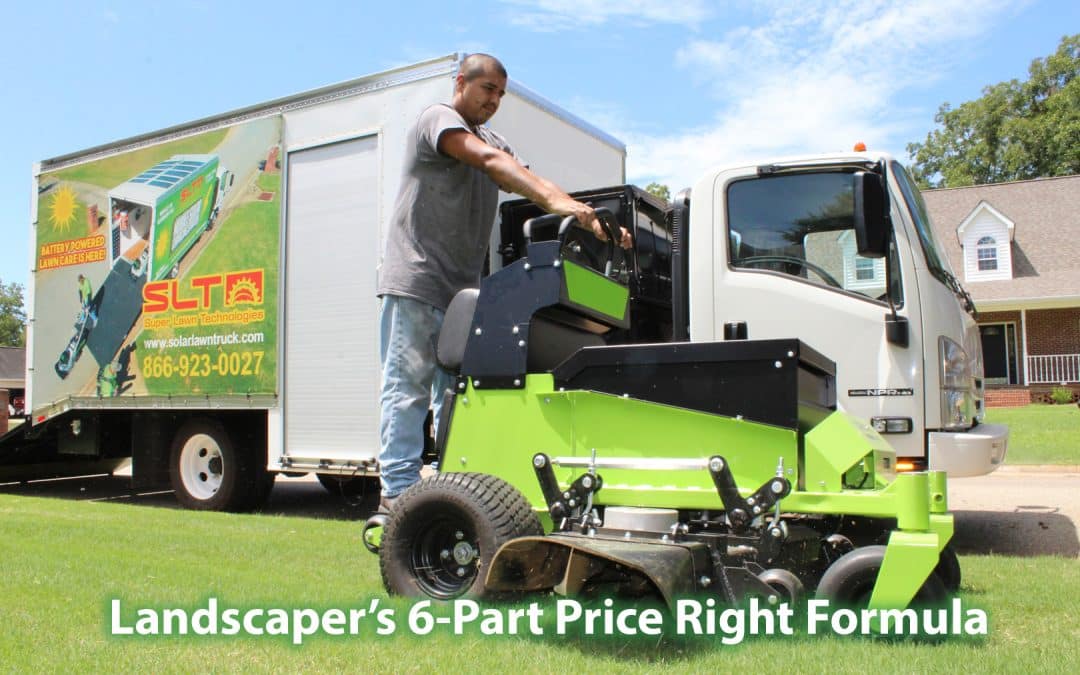Lawn and Landscape Business Owners:
Let’s get real for a minute. Running a lawn and landscape company ain’t for the faint of heart. If you’ve ever felt like you’re mowing in circles—working hard, making sales, but somehow not seeing the profits pile up—you’re not alone. And I can tell you exactly why: You ain’t pricing your jobs right!
Now, don’t take it personally. Pricing is where most landscapers go wrong. But lucky for you, there’s a formula—a simple, 6-part system—that will fix your pricing forever and put you on the path to predictable profits.
I introduced this formula in The E-Myth Landscape Contractor, and I’ve been preaching it ever since. It’s called the Price Right Formula, and if you execute these six steps, you’ll never have to guess, hope, or pray that your pricing is right again.
So, let’s break it down.
1. Budget – The Map to Profitability
Would you jump in your truck, hit the highway, and hope to find your way to success without a map or GPS? Heck no! But that’s exactly what landscapers do when they run a business without a budget.
Your budget tells you:
- How much revenue you need to cover costs and make a profit
- How much you should pay yourself (Yes, YOU get paid first!)
- Whether you can afford that new mower, truck, or crew
Without a budget, you’re playing a dangerous guessing game. And in this game, the house (Fedzilla, vendors, and expenses) always wins unless you plan ahead.
2. Overhead Recovery – Stop Working for Free!
Overhead is the silent killer of profit. It’s sneaky. It’s expensive. And if you ain’t pricing your jobs to recover overhead, you’re paying out of pocket just to stay in business.
Overhead includes all the costs that don’t go directly into a job—insurance, rent, trucks, office expenses, payroll taxes, and that cell phone glued to your ear.
The secret? You gotta build these costs into your pricing. Every job should contribute to covering overhead, not just materials and labor. If you don’t do this, you’ll be working hard, but your bank account will still be running on fumes.
3. Estimating – The Science of Profitable Pricing
Now we’re getting to the good stuff—estimating your jobs the right way.
Estimating is NOT just about guessing how long a job will take and slapping on a price. It’s a calculated process.
We call it Production Rate based estimating!
Every estimate should include a step-by-step Job Plan. Every step (and task) of the job is listed in order. No steps are skipped as you consider the most efficient way to execute the job.
For every task that includes equipment, you include the costs for the equipment.
You build the job or provide the service on paper – carefully considering ways to be a productive and safe contractor – before heading out in the field.
Slow down and think about ways to eliminate waste and how to prevent rework. You’ll soon have a plan that identifies:
- Labor costs (including drive time, setup, and cleanup)
- Materials (including waste and delivery fees)
- Equipment costs (because those mowers, loaders, and trucks ain’t free!)
- Overhead recovery (remember, that’s built into the price)
- Your break-even point (because working for free is called a hobby)
If you’re just throwing out numbers, hoping to “get the job” and “make it up on the next one,” you’re digging yourself into a hole. Profit starts with the estimate to identify your COSTS.
4. Bidding – Win Jobs Without Losing Money
Alright, you’ve estimated the job correctly—now it’s time to bid like a pro.
The goal is simple: Win the job at a profitable price. Not too high (so you lose to the lowballers), but not too low (so you lose your shirt).
Here’s a golden rule: Never let the customer’s budget determine your price. If they “only have $10,000” but the job costs $12,500 to do right, you don’t lower your price—you lower the scope!
You want to become a “value engineer” creating solutions to problems and enhancements to landscapes that buyers will buy from YOU!
And here’s an often overlooked strategy that can make you wealthy!
NEVER GIVE ONE PRICE EVER AGAIN!
Every proposal must include 3 options – not 2 options – not 4 options!
When you provide 3 options, you put the buyer back in control. You allow them to choose. In effect, you bid against yourself and prevent the buyer from calling another contractor to get a comparable quote.
We’ve found that almost any landscaper – young or old – will become instantly more trustworthy in the eyes of buyers using this strategy.
Smart bidders don’t race to the bottom. They educate customers on value, options, quality, and professionalism.
5. Sales – Price Is What They Pay, Value Is What They Get
Some landscapers think sales is about being the cheapest guy in town. WRONG.
Customers don’t buy based on price alone—they buy based on trust, confidence, and value.
The best salespeople:
- Sell solutions and packages, not hourly rate services (Your job is to solve their problem or provide an enhancement they will enjoy!)
- Explain the details of your work process (How they place the order, when can you start, how long the job will take, who they will communicate with during the job, and how to request a change order)
- Present the 3-option pricing with confidence (No stuttering or apologizing, highest price option is always presented first and lowest price option is presented last)
- Immediately explain the details of your warranty (What happens if there’s a problem, why you are confident they will be pleased, how long you stand behind your work)
- Ask for the order (Again, how they can place the order right now, when you can start, how long the job will take, why they should order today, why you’re excited about working for them)
- Follow up, follow up, follow up! (Most deals are closed AFTER the 7th conversation and very few landscapers follow-up 7+ times, automated and pre-scheduled follow-up can be a game changer)
Great sales skills mean closing deals at profitable prices—not just filling your schedule with low-margin work.
6. Job Costing – The Profit Report Card
Let’s get one thing straight: If you are not job costing, you’re blindfolded in business.
Job costing tells you if you actually made money on each job. Compare:
- Estimated labor vs. actual labor
- Estimated materials vs. actual materials
- Did you get an online review, referral or testimonial – this part multiplies profitable future sales
- Estimated profit vs. real profit
If you don’t track this, you won’t know where you’re losing money. And let me tell you—most businesses lose money on jobs they THOUGHT were profitable.
The Bottom Line: Follow the Formula, Build a Profitable Business
This 6-part formula isn’t just theory—it’s the real-world blueprint for running a successful landscape company.
- Set your budget (Know your numbers!)
- Recover overhead (Stop working for free!)
- Estimate right (Every job should be profitable!)
- Bid smart (Don’t race to the bottom!)
- Sell value (Not price!)
- Job cost everything (Measure, adjust, and improve!)
Do this, and you’ll finally take control of your profits—instead of wondering where all your money went at the end of the season.
Need help getting this dialed in? Let’s talk. The best time to fix pricing is NOW, before another year slips by.
Success is simple when you follow the formula. Execute it, and watch your business (and your bank account) grow!
Tony Bass, founder
866-923-0027
PS – We are holding the highly rated Profit Builder Training Event this month in Atlanta. Would you like to join us and learn the right price for your company? Call or text our Director of Training and Education, Tabitha Lovell at 678-943-4856.
You can register for the next Profit Builder Training Event online by clicking here.

